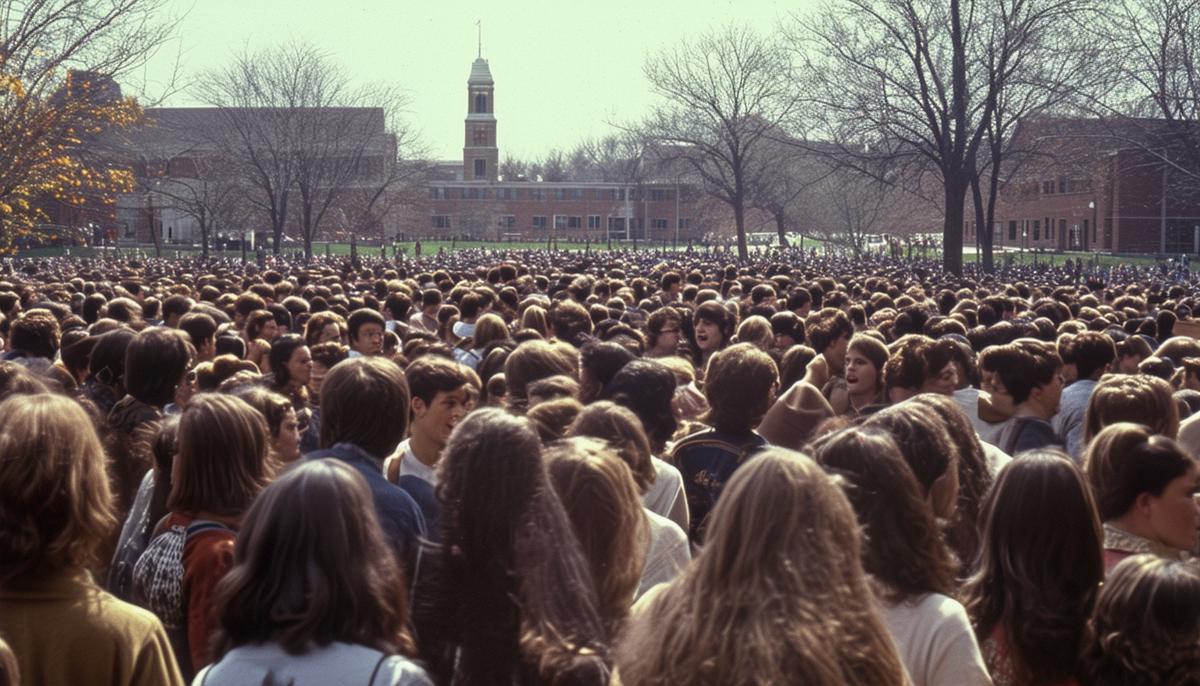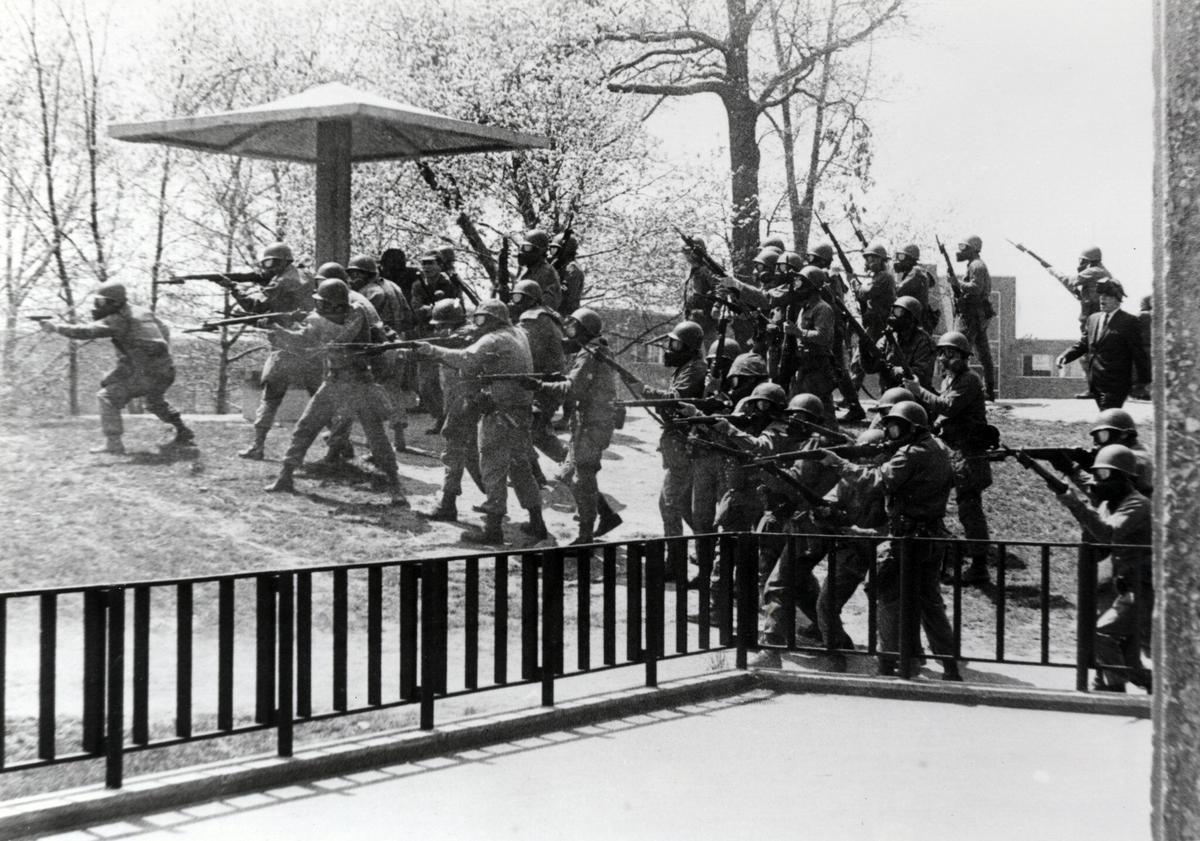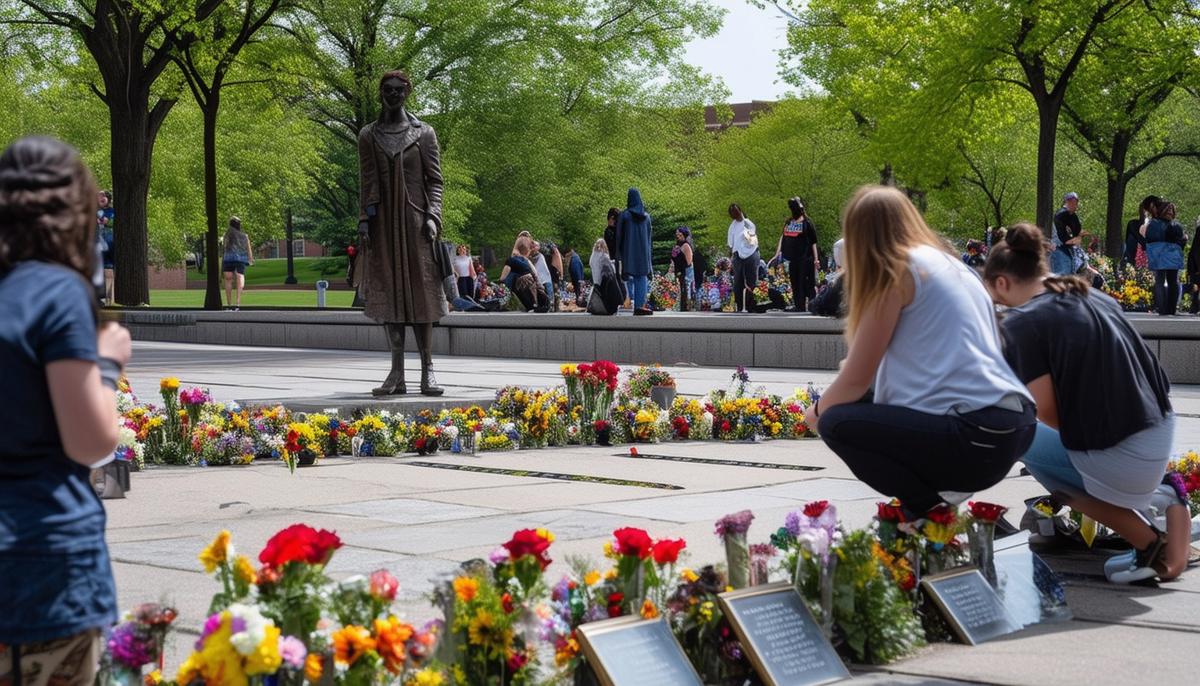Background and Context
Picture America in the late '60s and early '70s—a land buzzing with change. The Vietnam War took center stage, flashing across TV screens nightly. President Nixon, elected in '68, promised to end the war. But in April '70, he surprised everyone by invading Cambodia instead.
This move set already active campuses ablaze with protest. Kent State was no exception, with groups like Black United Students and Students for a Democratic Society stirring things up. By '68 and '69, sit-ins and calls to drop military training were common.
On May 1, 1970, frustration boiled over with broken shop windows in downtown Kent. Governor James Rhodes, channeling tough-talking politician vibes, sent in National Guard troops to keep the peace. With soldiers patrolling campus, confrontation seemed inevitable.
Consider today's college campus as a hotbed of learning and activism. Back then, students across America weren't just bookworms but vigilant voices against war and inequality. They rallied, shouted and sometimes pushed too far, igniting real change and leaving behind lasting lessons.
The Events of May 1-4, 1970
May 1 kicked off with a rally on Kent State's Commons. Students defiantly buried the Constitution, protesting Nixon's Cambodian invasion. That night, chaos erupted downtown with clashes between students and local police.
By May 2, the ROTC building was in ashes. Mayor Satrom called Governor Rhodes for backup, bringing in the Ohio National Guard. On May 3, Guardsmen took positions on campus as Rhodes ramped up rhetoric, calling protesters "worse than the Brown Shirts."
May 4 arrived with students gathering once more on the Commons. The scene was electric as the crowd faced off against troops. Amid chants and tear gas, chaos erupted. A confrontation, a retreat by troops, and then—an ear-piercing volley of bullets.
In 13 seconds, more than 60 shots rang out, leaving four students dead. The photos that emerged became powerful symbols—a stark reminder of the clash between youthful idealism and authority.

The Shooting Incident
On May 4, about 2,000 to 3,000 students gathered on the Commons, ready to protest despite previous bans. The Ohio National Guard arrived with M1 rifles, seemingly miscast in their role as peacekeepers.
As noon approached, tensions rose. Tear gas filled the air, but students remained, chanting against the wind. The Guardsmen advanced, pushing protesters toward Blanket Hill. Amid confusion and fear, someone shouted "Fire in the air."
For the next 13 seconds, rifle reports shattered the peace. When it ended, four students lay dead:
- Sandra Scheuer
- Jeffrey Miller
- Allison Krause
- William Schroeder
The aftermath left survivors tending the wounded and grappling with the unthinkable.
Kent State—once just a place of learning—had become the front line of a fierce debate. The event sparked nationwide dialogue, becoming a catalyst for awareness and a rallying cry for youth voices.

Immediate Aftermath and Reactions
News of the Kent State shootings spread like wildfire, reaching every corner of the nation. People huddled around TVs and radios, stunned by the unfolding tragedy. Newspapers splashed haunting images across front pages, igniting public outcry far beyond Kent's borders.
The White House faced intense scrutiny, with President Nixon feeling the heat of public anger. Students nationwide mobilized, emptying classrooms and filling streets with protests. Campuses became hubs of resistance, with cries of "Never again!" echoing across the country.
"We're going to put a stop to this!" – Governor James Rhodes, pounding the table at a press conference in Kent on May 3.
Yet amid the sorrow, a current of optimism surged. Many hoped this tragedy might lead to positive change, sparking a reevaluation of authority and freedom. The nation's youth had catalyzed a moment that would define generations to come, holding onto hope for a more harmonious future.
Legal and Historical Analysis
In the aftermath of Kent State, the legal system grappled with the tangled threads of justice and accountability. Courts struggled to find clarity amidst the confusion, facing a tragedy of unprecedented magnitude. Legal proceedings launched, putting the Ohio National Guard and various officials under intense scrutiny.
Investigations revealed conflicting accounts:
- Guardsmen claiming self-defense
- Allegations of unprovoked aggression against unarmed students
The legal process became a carnival of claims and counterclaims, with no single individual or entity bearing full responsibility. A series of trials and hearings delivered more questions than answers, leaving the world watching in dismay.
Despite the lack of judicial closure, Kent State championed deeper dialogues on protest rights. It exposed hard truths about:
- Governance
- Power dynamics
- The unyielding spirit of youth
The long-term historical significance of Kent State cannot be ignored. The event served as a stark lesson in American history—a cautionary tale etched into the national conscience. It sparked discussions across:
- Classrooms
- Coffee houses
- Legislative corridors
These discussions shaped policies on protest and law enforcement's role on campuses. Kent State propelled shifts in public perception, shattering idyllic visions of American campuses as mere academic havens. People began to treat university protests with sober comprehension rather than dismissal.
The tragedy laid bare the contrast between youthful idealism and entrenched authority—a lesson in restraint, negotiation, and the potential for change. Fifty-four years on, the legacy of Kent State endures—a groovy yet hard-hitting reminder. It's a peek back into a riveting past that still sows seeds of enlightenment, wrapped in the colorful quilt of activism that paved the way forward.
"The music of that moment—its defiance and heartache, its hope and resolve—thrums on, encouraging new generations to listen, learn, and grow from those indomitable student voices."

In the echoes of Kent State, we find a poignant reminder of the delicate balance between authority and youthful ambition. The events of those days continue to resonate, urging us to reflect on the enduring power of student voices and the profound impact they can have on shaping a more understanding world.
